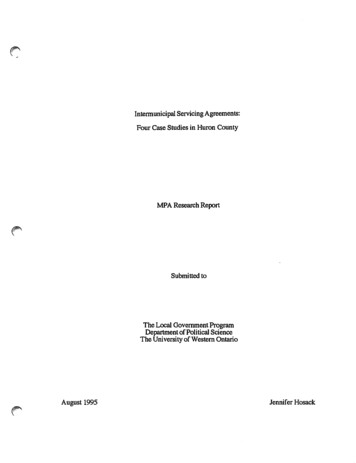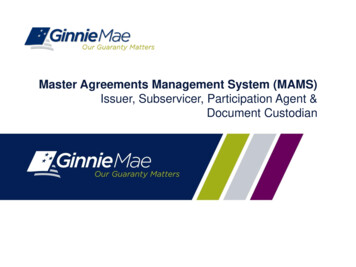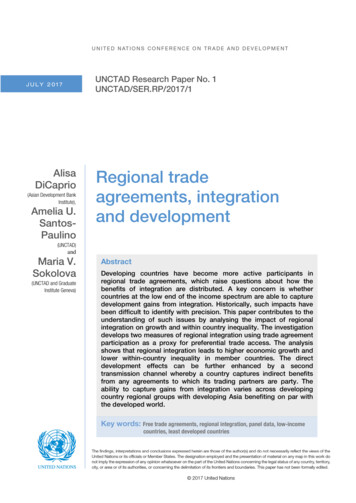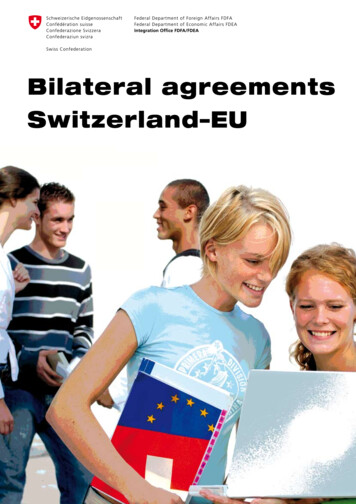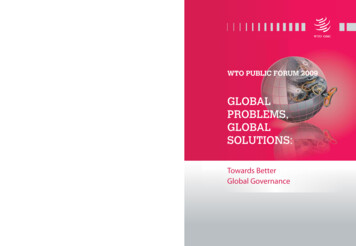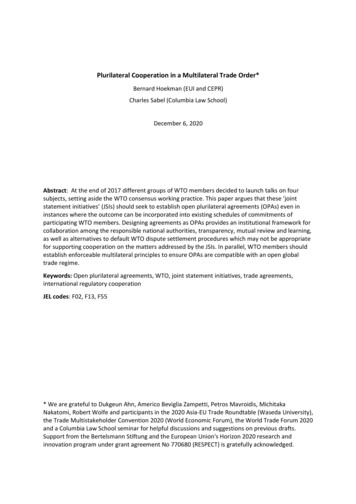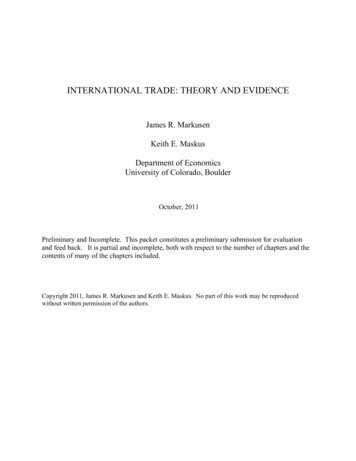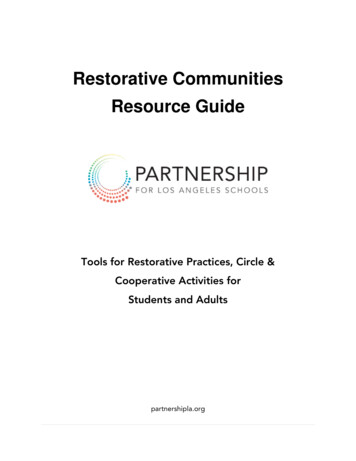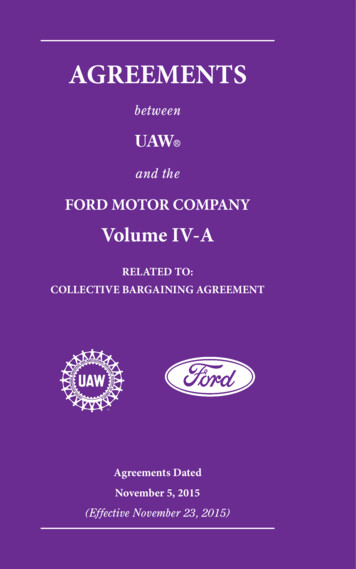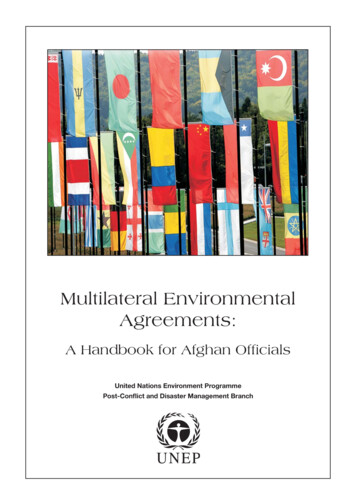
Transcription
Multilateral EnvironmentalAgreements:A Handbook for Afghan OfficialsUnited Nations Environment ProgrammePost-Conflict and Disaster Management Branch
First published in Kabul in 2008 by the United Nations Environment Programme.Copyright 2008, United Nations Environment Programme.This publication may be reproduced in whole or in part and in any form for educational or non-profit purposeswithout special permission from the copyright holder, provided acknowledgement of the source is made.UNEP would appreciate receiving a copy of any publication that uses this publication as a source.No use of this publication may be made for resale or for any other commercial purpose whatsoever without priorpermission in writing from the United Nations Environment Programme.Belinda BowlingEnvironmental Law and International Conventions ExpertUnited Nations Environment Programme (UNEP)Post-Conflict and Disaster Management BranchNational Environmental Protection Agency (NEPA)Darulaman, KabulAfghanistanTel: 93 (0)799 208 721E-mail: belinda.bowling@unep.chWeb: http://www.unep.orgDISCLAIMERThe contents of this volume do not necessarily reflect the views of UNEP, or contributory organizations. Thedesignations employed and the presentations do not imply the expressions of any opinion whatsoever on thepart of UNEP or contributory organizations concerning the legal status of any country, territory, city or area or itsauthority, or concerning the delimitation of its frontiers or boundaries.Design and Layout: Rachel Dolores
Table of ContentsAbbreviation Table . 4Author’s Note . 71 Introduction . 72 Overview of MEAs . 82.1The Meaning of the Term ‘MEA’ . 82.2Historical Development of MEAs . 82.3Different Types of MEAs . 92.4General Structure of MEAs . 92.5How an MEA Enters into Force . 102.6MEA Clustering . 122.7How MEAs Adapt and Evolve . 132.8Benefits of Being a Party to an MEA . 133 Implementation of MEAs . 163.1Overview . 163.2Compliance with MEAs . 163.3Enforcement of MEAs . 184 Description of the MEAs relevant to Afghanistan . 214.1Convention on Biological Diversity . 214.2United Nations Convention to Combat Desertification in those CountriesExperiencing Serious Drought and/or Desertification, Particularly in Africa . 234.3United Nations Framework Convention on Climate Change . 244.4Convention on International Trade in Endangered Speciesof Fauna and Flora . 264.5Vienna Convention for the Protection of the Ozone Layer. 274.6Montreal Protocol on Substances that Deplete the Ozone Layer . 284.7Convention on the Conservation of Migratory Species of Wild Animals . 304.8Ramsar Convention on Wetlands of InternationalImportanceEspecially as Waterfowl Habitat . 314.9Basel Convention on Transboundary Movementof Hazardous Wastes and their Disposal . 334.10Rotterdam Convention on Prior Informed Consent . 344.11Stockholm Convention on Persistent Organic Pollutants . 355 Participation in MEA Meetings and Negotiations . 385.1Preparation for Meetings . 385.2What to Expect at a Meeting . 385.3Political Background to Negotiations: Regional and Negotiating Blocks . 405.4Particular Challenges for Developing Country Coalitions . 425.5Reporting Back to the Afghan Government . 43Annex 1: Glossary of Commonly Used MEA Technical Terms . 44Annex 2: Checklist for an MEA Negotiator . 52Annex 3: Useful MEA Internet Sites . 53
Abbreviations(See also the Glossary set out in Annex 1)AOSISAlliance of Small Island StatesBasel ConventionBasel Convention on Transboundary Movement of Hazardous Wastes and theirDisposalCBDConvention on Biological Diversity (also referred to as UNCBD)CFCsChlorofluorocarbonsCHMClearing house mechanism (under the CBD)CITESConvention on International Trade in Endangered Species of Wild Fauna and FloraCMSConvention on Migratory Species of Wild AnimalsCOPConference of the PartiesCOWCommittee of the WholeDNADesignated National AuthorityECEuropean CommissionEUEuropean UnionFAOFood and Agriculture Organisation of the United NationsG-77Originally the Group of 77 developing countries established in 1964 at the firstsession of UNCTAD. Now 133 developing States.GEFGlobal Environment FacilityGHGGreenhouse gasICIMODInternational Centre for Integrated Mountain DevelopmentINCIntergovernmental Negotiating CommitteeIPCCIntergovernmental Panel on Climate ChangeJUSCANZNon-EU industrialised countries coalition (Japan, the US, Canada, Australia, NewZealand, Iceland, Mexico, Norway and Switzerland)LDCLeast developed countryMAILMinistry of Agriculture, Irrigation and LivestockMEAMultilateral Environmental AgreementMoFAMinistry of Foreign AffairsMontreal ProtocolMontreal Protocol on Substances that Deplete the Ozone LayerMOPMeeting of the PartiesNAPNational Action Plan (under UNCCD)NAPANational Adaptation Plan of ActionNBSAPNational Biodiversity Strategy and Action PlanNCSANational Capacity Needs Self-Assessment for Global Environmental ManagementNEPANational Environmental Protection AgencyNGONon-governmental organisationNOUNational Ozone Unit4Multilateral Environmental Agreements:
OECDOrganisation for Economic Cooperation and DevelopmentOzone TreatiesThe Vienna Convention and Montreal ProtocolPICPrior informed consentPOPsPersistent organic pollutantsPrepComsPreparatory committeesRamsar ConventionRamsar Convention on Wetlands of International Importance especially as WaterfowlHabitatRotterdam ConventionRotterdam Convention on Prior Informed ConsentStockholm ConventionStockholm Convention on Persistent Organic PollutantsUNCBDUnited Nations Convention on Biological Diversity (or Biodiversity Convention)UNCCDUnited Nations Convention to Combat DesertificationUNCEDUnited Nations Conference on Environment and Development (or Earth Summit,2002)UNDPUnited Nations Development ProgrammeUNEPUnited Nations Environment ProgrammeUNESCOUnited Nations Education, Scientific and Cultural OrganisationUNFCCCUnited Nations Framework Convention on Climate Change (or Climate ChangeConvention)UNICEFUnited Nations Children’s FundUNIDOUnited Nations Industrial Development OrganisationUNOPSUnited Nations Office for Project ServicesVienna ConventionVienna Convention on the Protection of the Ozone LayerWCSWildlife Conservation SocietyWEOGWestern Europe and Others GroupWMOWorld Meteorological OrganisationWWFWorldwide Fund for NatureA Handbook for Afghan Officials5
Author’s NoteThis handbook draws from five existing United NationsEnvironment Programme (UNEP) publications, namelythe Guide for Negotiators of Multilateral EnvironmentalAgreements, Compliance Mechanisms Under SelectedMultilateral Agreements, Glossary of Terms for Negotiatorsof Multilateral Agreements, Negotiating and ImplementingMEAs: A Manual for NGOs, and the Manual on Compliancewith and Enforcement of MEAs.This handbook has been produced in both Dari and Englishand is an output of UNEP’s Programme for Institutionaland Capacity Building for Environmental Management inAfghanistan, which was initially implemented in 2003 andis funded by the European Commission, the Government ofFinland and the Global Environment Facility.The intended audience for this handbook is the Governmentof the Islamic Republic of Afghanistan, particularly officialsfrom the National Environmental Protection Agency, theMinistry of Agriculture, Irrigation and Livestock and the Ministryof Foreign Affairs.Belinda BowlingMarch 2008The UNEP Capacity Building and Institutional Development Programmefor Environmental Management in Afghanistan is funded by the EuropeanCommission, the Government of Finland and the Global Environment Facility.6Multilateral Environmental Agreements:
1Introductionthe government, as well those officials responsiblefor compliance with, and enforcement of, MEAswithin Afghanistan.Neither environmental resources (such as wildlifespecies and forests) nor environmental problems(such as air or water pollution) respect thepolitical and administrative boundaries imposedby humans on the Earth that we all inhabit.As a result, many aspects of environmentalmanagement are regional or global in natureand need to be governed accordingly. Multilateral environmental agreements (MEAs) orenvironmental conventions or treaties, are themain vehicles used by governments across theglobe in order to achieve this.The United Nations Environment Programme (UNEP)has developed this handbook as a referencetool for Afghan government officials attendinginternational environmental meetings on behalf ofThe Annexes include a glossary of MEA terms, achecklist for MEA negotiators and a list of usefulMEA websites.This handbook covers all introductory aspects ofMEAs, including:What MEAs are; How MEAs are implemented; An overview of the MEAs to which Afghanistanis already Party, or those to which it intends tobecome a Party; and Provision of guidelines for participating in MEAinternational meetings and negotiations. IMAL HASHIMI Air pollution is an urban environmental problem in Kabul. It is also a regional and international problem, and is an example of an environmentalproblem that fails to respect borders and geographic boundaries.A Handbook for Afghan Officials7
2Overview of MEAsThis section provides a basic outline of the natureand scope of MEAs. It includes: The meaning ofthe term, an overview of the different types ofMEAs in place, the legal nature of MEAs, theiradministrative structure and how MEAs evolve toadapt to new challenges and developments.2.1 The Meaning of the Term ‘MEA’A multilateral environmental agreement is alegally binding agreement between two ormore countries containing commitments to meetspecific environment-related objectives.Two elements of the definition are important tounderstand: Legally binding: MEAs are legal instruments.They bind the countries that have agreedto become a Party through ratification oraccession. Countries that have signed buthave not yet ratified an MEA are nonethelessexpected not to do anything that could affectthe aims and purposes of the agreement.MEAs are not declarations of intention but arerules of international law. As such, an MEA is apowerful tool for the implementation of policieswith environmental protection and sustainabledevelopment goals.Between two or more nation States: Thebetter-known environmental agreements aremultilateral in the sense that they involve manynations and generally deal with broad aspectsof environment (e.g. climate, biodiversity etc.).However, the term MEA can refer to any treatybetween two or more nations if, and when, itdeals with direct environmental objectives.2.2 Historical Development of MEAsMEAs, in some form, have been in place for abouta hundred years. However, most have developedin the last three decades, especially since the1972 International Stockholm Conference onHuman Environment. Some studies conservativelyestimate that approximately 700 MEAs arecurrently in place. Their proliferation is mainly dueto an appreciation of the gravity of environmental8problems facing our planet today (largelyas a result of human activity), plus a growingunderstanding that environmental issues are oftennot only local in nature, but also regional andglobal. Therefore, the solutions and tools to dealwith them should also be regional and global intheir scope.The first MEAs were quite different from ones signedand coming into force of recent years. They wereusually aimed at protecting a particular species,e.g. a species of fauna, such as the snow leopard.Earlier agreements also tended to deal with oneparticular media, for example, oceans. However,over time and as appreciation of the interlinkednature of ecological processes developed, suchsectoral approaches were gradually abandonedin the quest for more integrated considerationsand, as a consequence, more integratedmechanisms and solutions.That said, MEAs remained sectoral until the early1990s in the sense that they did not incorporatespecific sustainability approaches and only dealtwith environmental protection or conservation. Whilethe first generation of MEAs were use-oriented, themore recent ‘second generation’ took a more holisticapproach, focusing on sustainable developmentand sustainable use of natural resources. Thelater MEAs were born out of the United NationsConference on Environment and Development(UNCED) in 1992 (otherwise known as the ‘EarthSummit’ or ‘Rio Conference’) where governmentsacross the globe acknowledged the interactionbetween society and biophysical problems,and began to recognise intimate links betweendevelopment and the environment. Recent MEAsfully concede these aspects as crucial.The Earth Summit was held in Rio de Janeiro,Brazil in 1992 and was attended by governmentrepresentatives from approximately 180 States,including Afghanistan. Two new conventions wereopened for signature here – 1) The UN FrameworkConvention on Climate Change (UNFCCC),which is sectoral in that it deals with climate andthe atmosphere but also recognises the broaderimpacts of climate change on ecosystems, foodproduction and sustainable development; and2) The Convention on Biological Diversity (CBD),which seeks to bring together agriculture, forestry,fishery, land use and nature conservation in newMultilateral Environmental Agreements:
of CITES includes species not necessarilythreatened by extinction, but whose trademust be controlled in order to avoid utilisationincompatible with their survival. Appendix III ofCITES includes species protected in at leastone State, which has requested other CITESParties for assistance in controlling the trade.ways. A third convention was adopted after theConference: 3) The UN Convention to CombatDesertification (UNCCD), which aims to combatdesertification and mitigate the effects of drought.These three conventions are often referred to as‘the Rio Conventions’.2.3 Different Types of MEAsThere are five main categories of MEAs. However,it should be noted that an MEA can fall into morethan one category (for example, the Conventionon International Trade in Endangered Species ofWild Fauna and Flora (CITES) is both a multilateralMEA and an appendix-driven one).1) Global or Multilateral MEAsThis type of MEA have been signed by themajority of the world’s States. Examples includethe Convention on Biological Diversity (CBD)and the Desertification Convention (UNCCD).2.4 General Structure of MEAsMost MEAs include a series of structures thatfacilitate their implementation and also run theactivities that arise out of the agreement. Althoughthere might be more institutional arrangementsthan these listed, the following outline the basicorganisational compositions that are set up afteran MEA is adopted. 2) Bilateral MEAsAn agreement between two countriesconcerning an aspect of environmentalmanagement. An example is the Treatybetween Argentina and Chile on theEnvironment (1991).– Reporting on compliance;– Upholding information systems related to theConvention and the issues it deals with;3) Regional MEAsThese MEAs are restricted to a specificgeographical region. For example, theBamako Convention on the Ban of the Importinto Africa and the Control of TransboundaryMovement and Management of HazardousWaste within Africa (1991).4) Framework MEAsThis type of MEA require further agreements(protocols) to provide the necessary standards,procedures and other requirements toimplement the MEA effectively. An example isthe Climate Change Convention (UNFCCC).5) Appendix-driven MEAsThese agreements rely heavily on appendicesfor their operation. CITES and CMS are twoexamples. Appendix I of CITES includes speciesunder threat of extinction, so internationaltrade in these species is permitted only inexceptional circumstances. Appendix IIA Handbook for Afghan OfficialsSecretariat: Secretariats undertake theday-to-day activities of coordinating theimplementation and make arrangements forthe meetings of the Conference of the Parties(COP). Secretariats provide support for the MEAParties in tasks such as:– Employing or fostering financial mechanismsfor projects dealing with MEA implementation;and– Assisting and servicing the periodic meetingsof the COP or Meeting of the Parties (MOP)for protocols or regional agreements. Conference of the Parties (COP): Countriesthat ratify after adoption and signatureor accede to a particular internationalagreement, are called Parties. They meetperiodically through Conferences of Parties toassess different aspects and implementationof MEAs. The goals of these conferencesinclude: Appraising the implementation process ofan MEA at the national levels. This is done byevaluating all reports, submitted by differentnational governments, to the COP; Deliberating on all aspects of the MEAs;9
COURTESY OF IISD REPORTING SERVICES / EARTH NEGOTIATIONS BULLETINZahid Ullah Hamdard, Afghanistan (right), noted assistance from UNEP, Germany and others in the preparation of his country’s national phaseout plan. 18th Meeting of the Parties to the Montreal Protocol (MOP-18), 3 November 2006, New Delhi, IndiaDiversity and Climate Change was establishedto consider ways to promote synergies at thenational level between the UNFCCC and the CBDwhen implementing climate change activities,as well as their relation to the conservation andsustainable use of biodiversity. Resolving new or additional issues that needto be settled for the implementation of theMEA; Revising the treaty when, and if, necessary. 10Meeting of the Parties (MOP): A MOP is similarto a Conference of the Parties. The term ‘MOP’is used to describe meetings to the MontrealProtocol (substances that deplete the ozonelayer), in order to distinguish these meetingsto the framework conventions themselves(the Vienna Convention in the case of theOzone Treaties). A MOP will often be held inconjunction with a COP.Scientific body: Formal scientific bodiesauthoritatively accompany MEAs. They providea more comprehensive evaluation of how theenvironmental issue that the MEA deals with isbeing confronted, as well as exploring scientificand technical issues related to the agreement’sissues. Although nominated by Parties (i.e.countries that are a part of the treaty), a MEA’sscientific group acts independently by providingits own assessments as well as neutral advice.Ad hoc groups: These groups may be createdto address specific issues of concern thatrequire focused attention. For example, anad hoc Technical Expert Group on BiologicalThe following institutional terms are relevant to COPand MOP meetings: Plenary: The main meeting of the COP orMOP. At plenary meetings, each delegation isrepresented and all delegates sit in a singlelarge room. State representatives have anopportunity to address the Convention. Allvotes take place in the plenary meeting. Bureau: A Bureau may oversee the running ofa COP or MOP. Bureaus are usually made up ofmembers from each of the different regionalblocs. Informal Bodies: The President of the COP orthe Chair of a subsidiary body may establish‘informal consultations’ (or other groups) to helpfind consensus among the diverse interests ofMEA Parties.Further relevant terms are set out in Annex 1 whichcontains a glossary of MEA terms.Multilateral Environmental Agreements:
When this process is concluded the INC mayorganise an ad hoc conference, specificallydesigned for the purpose of negotiating anagreement. Intergovernmental organisationsoften provide Secretariats to oversee adhoc conferences. This was the case in thenegotiations of the 1998 Convention on PriorInformed Consent, where UNEP and FAO jointlyprovided a Secretariat.2.5 How an MEA Enters into ForceAll MEAs differ in scope and substance. Nevertheless,they tend to be formulated through a similarprocess that moves through five distinct stages,namely: pre-negotiation, negotiation, adoptionand signature, ratification and accession, andentry into force. Pre-negotiation phaseIn the pre-negotiation stage, nationalgovernments or intergovernmental organisations set out to address environmentalissues that have implications beyond nationalboundaries, or those issues of global concern.The first step involves deciding if there is a needfor action, and whether joint action is feasible.Informal or formal consultations at this stagecan take place at the national, regional orinternational level.Scientific analysis is usually a key componentof pre-negotiation analysis. Intergovernmentalorganisations may call for the creation ofa scientific body to investigate a particularissue. For instance, in 1988 UNEP and the WorldMeteorological Organisation (WMO) calledfor the creation of the IntergovernmentalPanel on Climate Change (IPCC) to provideindependent scientific analysis concerningthe rising threat of climate change. The IPCC’sfindings, set out in its First Assessment Reportin 1990, provided the scientific basis for thenegotiation of the UN Framework Conventionon Climate Change.The pre-negotiation phase also involves theassessment of existing legal regimes. Thisoften includes a review of national laws andregulations, as well as binding and nonbinding international agreements that addresssimilar environmental issues. Negotiation phaseThe negotiation process begins with theestablishment of a negotiating structure.Negotiating structures usually arise wheninternational bodies, such as UNEP, convenean Intergovernmental Negotiating Committee(INC). Before negotiations begin, preparatorycommittees (PrepComs) may be established toaddress issues of procedure and cost.A Handbook for Afghan OfficialsThe INC may also establish subsidiary bodies,such as a Bureau to help organise thenegotiating process or working groups tofocus on specific negotiating issues. If rules ofprocedure were not agreed upon during thepreparation process, the ad hoc conference’sfirst order of business may be to createprocedural rules to help guide the negotiationprocess itself. In the ad hoc conference,participants may engage in ‘formal’ and‘informal’ negotiations. Formal negotiationstake place primarily in the plenary body whereall Parties are present. Informal negotiations,in contrast, occur largely behind closed doorswith smaller groups of key players. Adoption and signatureUpon conclusion of the negotiation phase,attention shifts to the next phase – adoptionand signature. The formal adoption andsigning of an MEA may take place at eithera diplomatic conference or a conferenceof plenipotentiaries. An enabling decision isadopted by the convening body (e.g. theUN or a specialised agency like UNEP), whichdetails the purpose, dates, and venue ofthe adoption and signature conference. Asin the negotiation phase, the adoption andsignature conference is guided by establishedprocedural rules. However, in practice,Parties enter into an agreement to extendthe procedural rules that were applied to thenegotiating sessions. In theory, a conferencefor adoption and signature could be convenedjust hours after the completion of negotiations.However, in practice, these conferencestake place some time after the conclusion ofnegotiations. This allows time for both the INCsecretariat to prepare necessary documents,and for negotiators to report the results of thenegotiations to their respective governments.11
Ratification and accessionOften MEAs allow countries to sign agreements‘subject to ratification’. Governments are thengiven time to internally consider their formalposition on the agreement. The process ofratification ensures that country representativeshave not overstepped their authority innegotiating the MEA. By ratifying an agreement(by depositing an ‘instrument of ratification’)a country formally declares its consent to bebound by the MEA’s terms. Typically, there is aformal period of time for which an agreement isopen for ‘ratification’ by the governments signing.However, in certain instances the actual signingof an MEA may amount to ratification. For thisreason any country representatives attendingan adoption and signing conference shouldhave the full authority of their governments toadopt and sign the MEA being agreed.Accession is fairly similar to ratification. If a countryseeks to make a formal commitment to the MEAafter the allotted timeframe for ratification hasexpired, this is termed as ‘accession’. At thenational level, each country determines its owninternal ratification process for internationalagreements. Hence different countries mayuse different terminology for the process ofratification. The ‘depositary’ takes custodyof the original treaty text and collects anydocuments relating to it (signatures, ratifications,accessions, reservations, notifi-cations and othercommunications). The depositary then examineswhether the documents presented are in properform and if the conditions required for the entryinto force of an instrument have been met. 12Entry into forceDuring the pre-negotiation or negotiationphases, Parties will agree to specific rulesregarding entr y into force of the MEA.Most MEAs employ a system in whichentry into force depends on a requirednumber of ratifications, acceptances,approvals or accessions received. Thisensures the achievement of a critical massof participating States so that the Partiescommitting to the agreement are capableof realising its goals and objectives. Normally,MEAs require anywhere from 20 to 30 percentparticipation of potential Parties. Anothertrend with environmental agreementshas seen entry into force linked with themandatory participation of certain Parties.The 1997 Kyoto Protocol to the United NationsFramework Convention on Climate Changerepresents an example of this strategy. TheKyoto Protocol made two requirements forentry into force. These were: Ratification by at least 55 Parties to theUNFCCC; and Ratification by Annex I Parties (developedcountry Parties) accounting for at least 55percent of the total 1990 level of carbondioxide emissions from all developedcountry Parties listed in Annex I.Both requirements had to be met before theProtocol could enter into force. This level ofparticipation was designed to ensure thatmajor developed countries participated. It wasalso designed to ensure broad participationin recognition of the economic implicationsof ratification and compliance with Kyoto’semission reduction targets.Once an MEA ‘enters into force’ it takes legal effectand implementation begins. As implementationgoes forward there may be a need to adapt theMEA’s institutions, mechanisms and approaches tobe able to adapt to changes in science and knowledge, or to build upon the progress that has beenachieved through the negotiation of new decisions,amendments, annexes, appendices or protocols.Multilateral environmental agreements must conformto international public law (as must all internationalinstruments of this type). The compliance is guidedby the 1969 Vienna Convention on the Law ofTreaties. This treaty, which entered into force in1980, prescribes the components and generalguidelines for the development, negotiation andadoption of international treaties.2.6 MEA ClusteringAfter beginning to work with MEAs it becomesapparent that there is a vast degree offragmentation, and yet – at the same time – agreat deal of overlap among them. The overlaps,Multilateral Environmental Agreements:
CBD CONVENTION ON BIOLOGICAL DIVERSITYA plenary view of the closing section of sixth meeting of the Ad Hoc Open-ended Working Group on Access and Benefit-sharing under theConvention on Biological Diversity, 2008.fragmentation, and proliferation of MEAs haveresulted in the following obstacles: Increasing ‘double-work’ causing potentialconflict or confusion between different MEAs; Increasing requests for coordination amongand between different MEA structures; and Increasing funding required by developingcountries and non-State actors to
6 Multilateral Environmental Agreements: Author's Note This handbook draws from five existing United Nations Environment Programme (UNEP) publications, namely the Guide for Negotiators of Multilateral Environmental Agreements, Compliance Mechanisms Under Selected Multilateral Agreements, Glossary of Terms for Negotiators
